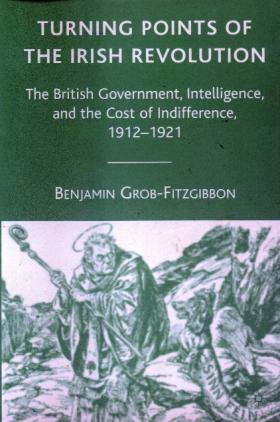Turning points of the Irish revolution: the British government, intelligence and the cost of indifference, 1912–1921
Published in 20th-century / Contemporary History, Issue 3 (May/Jun 2008), Reviews, Revolutionary Period 1912-23, Volume 16 Turning points of the Irish revolution: the British government, intelligence and the cost of indifference, 1912–1921
Turning points of the Irish revolution: the British government, intelligence and the cost of indifference, 1912–1921
Benjamin Grob-Fitzgibbon
(Palgrave Macmillan, £42.50)
ISBN 9781403980038
This is a well-structured book that provides the first sustained analysis of Colonial Office intelligence reports from 1913 to 1920. These indicate that Dublin Castle was better informed about the secret activities of the Irish and especially the Ulster volunteer forces than many historians have believed. It is also shown that the militant faction of the Irish Volunteers grew in size perpetually from the spring of 1915 onwards and engaged in numerous attacks on RIC barracks during 1917–18. The author typifies this as ‘an unacknowledged insurgency’ for two reasons: first, it was deemed insignificant by the contemporary British administration owing to its preoccupation with the war in Europe; second, it has been overlooked by historians, who have assumed that such activities did not begin until January 1919. Unlike the earlier sections of his book, the author’s account of the troubles of 1919–21 is brief and based primarily on other historians’ work.
Grob-Fitzgibbon provides a good and succinct analysis of the operations of the Chief Secretary’s Office, but his interpretation of the politics of that administration has a number of weaknesses, most notably a failure to contextualise the revolution in the light of events prior to 1912. While (as the author notes) all coercive legislation used during the revolution was first implemented during the 1880s, the British administration’s ongoing confidence that a political solution to the Irish question could be found based on the precedent of 1886 is not analysed but is simply deemed inexplicable by the author. A second weakness is his relatively poor understanding of the relationship between the civil and military aspects of the British administration. Noting the British Army’s increasing frustration regarding its inactive and ill-defined role in Ireland (the army’s operations were confined strictly to providing personnel in support of the ‘civil power’, the RIC), the author argues that the civil administration’s unwillingness to order drastic military measures on the basis of intelligence received was a serious political misjudgement, allowing the Ulster Volunteer Force (UVF) to give rise to the Irish Volunteers, which in turn gave birth to the IRA. He suggests that the entire Irish revolution could have been prevented if these movements, beginning with the UVF, had been nipped in the bud. This inaction is deemed by the author to have been the result of a costly indifference, but this judgement misinterprets the essential nature of the relationship between the civil and military aspects of the British administration and also underestimates the significance of the Curragh mutiny of 1914.
Correspondence quoted by the author shows that the directors of British intelligence relied almost entirely on the advice of the leaders of the Irish Parliamentary Party in formulating their strategy for maintaining the Union in Ireland throughout the 1910s. Some of the author’s misjudgements of the political context of the revolution stem from his acceptance (notwithstanding his production of evidence to the contrary) of the common misconception that the Irish Party was committed to breaking rather than strengthening (through reforming) the Union ever since it secretly negotiated with Gladstone in 1886. If, as the author suggests, the government badly misjudged the danger posed by the Ulster and Irish Volunteers, this clearly originated in the fact that both these organisations were more aware of the frailty of the Irish Party’s hold on the country. Likewise, they knew very well that there was a real possibility of unilaterally seizing the political initiative and paralysing the existing political establishment and British administration in Ireland by directly challenging and supplanting the authority of the RIC, the crutch of its ‘civil power’. Indeed, that this was the fundamental aim and achievement of both organisations is amply illustrated by the range of their activities, which Grob-Fitzgibbon himself details extensively.
Hitherto historians have examined the UVF and the Irish Volunteers/IRA in complete isolation from each other, thereby (it could well be argued) failing to contextualise the history of either. Notwithstanding some interpretative shortcomings, Grob-Fitzgibbon is to be commended for providing the first sustained analysis covering the history of both organisations, which makes this book a particularly valuable source for all students of the course of the Irish revolution from 1912 up to 1920.
Owen McGee is a historian from Greystones, Co. Wicklow.


















